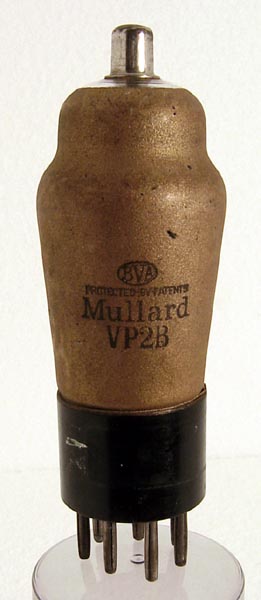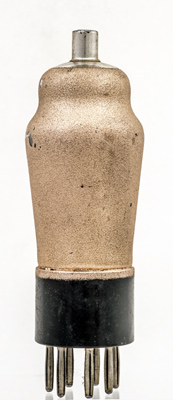|
VP2BSensibly equivalent¶ to:CV520
|
|
|

|
The VP2B is unusual in that it is a variable μ hexode. What was the VP2B was really intended for? Mullard quote ratings and characteristics for use as a mixer, a pentode and a tetrode. About the same time in 1937 Hivac introduced their 'Universal' Type A15 which was intended to serve as RF amplifier or frequency changer or detector or AF amplifier or output valve or HT rectifier merely by connecting it in different ways. Unfortunately the Jack of all trades is the master of none and the A15 sold like the proverbial lead balloon. Today they are very rare.When used as a mixer the VP2B would need a separate oscillator valve so there doesn't seem to be much saving there. As far as we know it was normally used connected as a pentode when used in domestic radios. It can only be assumed that Philips had some arcane purpose for this valve and that Mullard were obliged to make and market a British version of it. Even more interesting is that the Tungsram Type VP2B actually is a pentode, not a hexode! This battery valve was designed to run from an accumulator supply for the filament and dry batteries for the anode could have its amplification altered by altering the grid bias voltage, as for any variable μ type. If used in a superhet receiver the automatic gain control (AGC) derived from the rectified output could be used to alter the gain of RF and IF stages to avoid distortion.
The reverse is unmarked.The classic envelope is 42 mm in diameter and, excluding the B7 base pins, is 107 mm tall.References: Data-sheet, private communication, 1048 & 1040. Type VP2B was first introduced in 1937. See also 1937 adverts. |
Pin Connections
| 1 | 2 | 3 | 4 | 5 | 6 | 7 | tc |  m | a | g3 | f | f | g4 | g2 | g1 |
|
|
Absolute Maximum Operating Conditions¶
| Vh | Ah | Va | Vs | Vg | mAa | mAs | ra | gm | 
| 2.0 | 0.135 | 135 | 60 | -1.5 | 2.0 | 0.95 | 1.3M | 1.4 |
|
PDF scanned from an original document held by the museum |
Updated August 04, 2023.
|
|